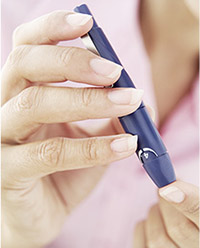Diabetes can indeed “run in families,” meaning that heredity often makes someone more likely to develop diabetes. Researchers believe that certain genes affecting immune response can play a role in the development of type 1 diabetes, while genes affecting insulin function can contribute to the development of type 2 diabetes. While African Americans, Hispanic/Latino Americans, American Indians, Asian Americans, and Pacific Islander Americans have a slightly lower rate of type 1 diabetes, they are at a higher risk for type 2 diabetes than the rest of the population.
Many researchers think that some African Americans, Hispanic/Latino Americans, American Indians, Asian Americans, and Pacific Islander Americans inherited a “thrifty gene” which helped their ancestors store food energy better during times when food was plentiful, to survive during times when food was scarce. Now that “feast or famine” situations rarely occur for most people in the United States, the gene which was once helpful may now put these groups at a higher risk for type 2 diabetes.
In addition, poverty, lack of access to health care, cultural attitudes and behaviors are barriers to preventive and diabetes management care for some minority Americans.




 And Other Power Foods >
And Other Power Foods >